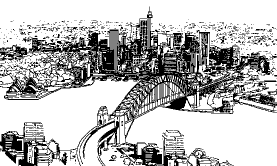| Population and Environment in Australia | ||
Pollution A major contributor to air pollution in Australian cities is the motor vehicle, the number of which increases with rising populations. Motor vehicles are responsible for 80 to 90 per cent of carbon monoxide and lead emissions, and 50 to 80 per cent of hydrocarbon and nitrous oxide emissions. Although technological changes and regulations have kept some emissions in check, ozone and nitrogen dioxide have increased to unacceptable levels in the large cities. Photochemical smog sometimes goes above national health guidelines in areas of Sydney such as the south-west and around Melbourne. It is because of concerns about air quality that the NSW Government has decided to limit housing development in the south-west of Sydney. However, since the pollutants flow there from elsewhere in the city, this may be a rather limited solution. Water pollution resulting from flows of domestic sewage and urban run-off is also related to population levels (although it is also a function of treatment and urban design). Sydney's Nepean&endash;Hawkesbury river system is already under severe stress because of urban development. Nutrient, bacteria and virus levels are high because of inflows of sewage and agricultural run-off. Yet the NSW Government is proposing to develop additional housing for thousands of families within the catchment of this river system, adding to its load. Water supply is said to be another potential constraint on population growth in many parts of Australia. For example, the population issues committee estimates that new sources of water will have to be found early next century if increases in population and use of water per person in the Sydney area continue to grow as they have been. This would probably mean a dam on the Shoalhaven River, which would not only be expensive and energy intensive because of the pumping that would be required, but would also be environmentally undesirable, as would the alternative of raising the level of the Warragamba Dam. Nevertheless, while water is in relatively short supply in Australia, its use depends not only on population levels but also on agricultural and industrial consumption and how efficiently the water is collected, distributed and used. Disposing of the solid waste from large populations causes environmental pressure in cities. Domestic solid waste generated by households accounts for one-third to one-half of all solid waste generated in large cities. This amount depends on the numbers of people and the amount of rubbish they each generate. The population issues committee estimates that almost half of the growth in solid waste is due to population growth, and just over half is due to increased resource use per person (1992, p. 60). Increased recycling and reuse and less throw-away packaging could also affect the relationship between numbers of people and the garbage generated. Each year, Sydney and Melbourne residents generate hundreds of thousands of tonnes of paper and cardboard, glass, plastic, and other wastes. Solid waste is generally buried in the ground, which has a number of adverse environmental consequences. Resources are wasted, land is used up, smells and visual nuisances are created, and groundwater may be polluted. The waste often has to be transported long distances to be buried. If it is incinerated, the resources are still wasted and toxic air emissions are generated. Population increase also puts pressure on existing housing, raising prices and forcing some people out of the city because they cannot afford to live there. Some people respond to rising prices by moving to the outer fringes of the city, promoting urban sprawl. Generally, these fringe areas are poorly served by public transport and other community facilities, so urban sprawl involves additional motor vehicle travel to work and to community facilities. It can also mean that prime agricultural land is turned over to residential developments. The NPC's population issues committee concludes that, although there is still far more to learn about the links between population levels and environmental impacts, 'there is some significant evidence of negative influence of urban population growth on urban ecological integrity' (p. 60). Some people move out of the cities because they find them congested and unpleasant. Often, they move to the coastal regions where they find a beautiful natural environment. However, as more people move to these areas, species preservation can be threatened and the natural environment damaged.
Source: Sharon Beder, The Nature of Sustainable Development, 2nd ed. Scribe, Newham, 1996, pp. 161-3. A Russian translation of this page by ResumeCoversCV can be found at: http://find-article-translated.com/categories/science-and-technologies/population-and-environment-in-australia/ A Ukrainian translation of the page has been completed by TheWordPoint source and can be found at https://gettranslate.org/naselennya-dovkillya-avstraliyi/A Croation translation of this page can be found at: http://pro4education.com/stanovnistvo-i-okolis-u-australiji/ |
© 2001 Sharon Beder

